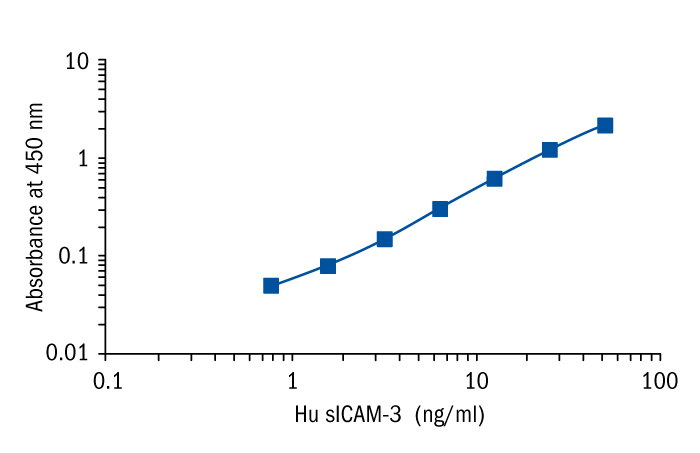Type
Sandwich ELISA, HRP-labelled antibody
Applications
Serum, Plasma-EDTA, Plasma-Heparin, Urine, Amniotic fluid, Cell culture supernatant
Sample Requirements
20 µl/well
Shipping
At ambient temperature. Upon receipt, store the product at the temperature recommended below.
Storage/Expiration
Store the complete kit at 2–8°C. Under these conditions, the kit is stable until the expiration date (see label on the box).
Calibration Curve
Calibration Range
0.78–50 ng/ml
Limit of Detection
0.38 ng/ml
Intra-assay (Within-Run)
CV = 2.5%
Inter-assay (Run-to-Run)
CV = 2.0%
Spiking Recovery
106,00%
Dilution Linearity
96,00%
Research topic
Cell adhesion proteins
Summary
Intercellular Adhesion Molecule-3 (ICAM-3) is a member of the immunoglobulin supergene family and functions as a ligand for the Lymphocyte Function-Associated Antigen-1 (LFA-1). Three counter-receptors have been described for LFA-1, intercellular adhesion molecule 1 (ICAM-1), ICAM-2 and ICAM-3. LFA-1, an alpha-beta complex, is a member of the leukocyte integrin family which mediate lymphocyte adhesion.
ICAM-3 is a heavily glycosylated protein of 124 kDa with a polypeptide core of 57 kDa. The integral membrane protein with five immunoglobulin-like domains shares high homology to ICAM-1 and ICAM-2 in the extracellular region. In contrast to ICAM-1 and ICAM-2, ICAM-3 is absent on endothelia. ICAM-3 is expressed on resting lymphocytes, monocytes and neutrophils, representing the major LFA-1 ligand on these cells. The finding that adhesion of resting T lymphocytes to LFA-1 occurs primarily via ICAM-3 combined with the fact that ICAM-3 is much better expressed than other LFA-1 ligands on monocytes and resting lymphocytes implies an important role for ICAM-3 in the initiation of immune responses. ICAM-3 was found to be involved in the regulation of LFA-1/
ICAM-1 dependent leukocyte intercellular interactions. The initial interaction of ICAM-3 with LFA-1 might increase LFA-1-mediated cell binding to ICAM-1. Furthermore, ICAM-3 expression has been shown for dendritic epidermal Langerhans cells, whereas it is absent on other dendritic cells from different lymphoid organs. Thus potential function of ICAM-3 at the initiation phase of LC-leukocyte interactions taking place during skin
localized immune reactions can be postulated. Recent data suggest that ICAM-3 expression can be induced on endothelial cells in lymphoid neoplasms as shown for Hodgkin's and non-Hodgkin's disease. ICAM-3 is a very interesting molecule involved in the initial immune response thus suggesting an important role as a disease marker for a number of different indications and pathological situations.
Instructions for Use (RUO)
Instructions for Use (RUO)
Safety Information (RUO)
MSDS (RUO)
Find documents for the lot

